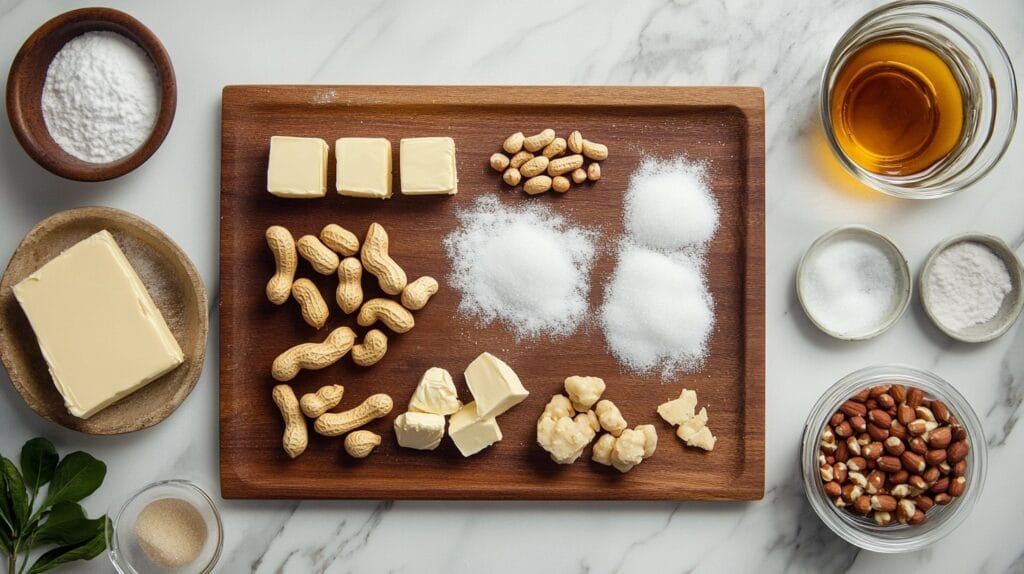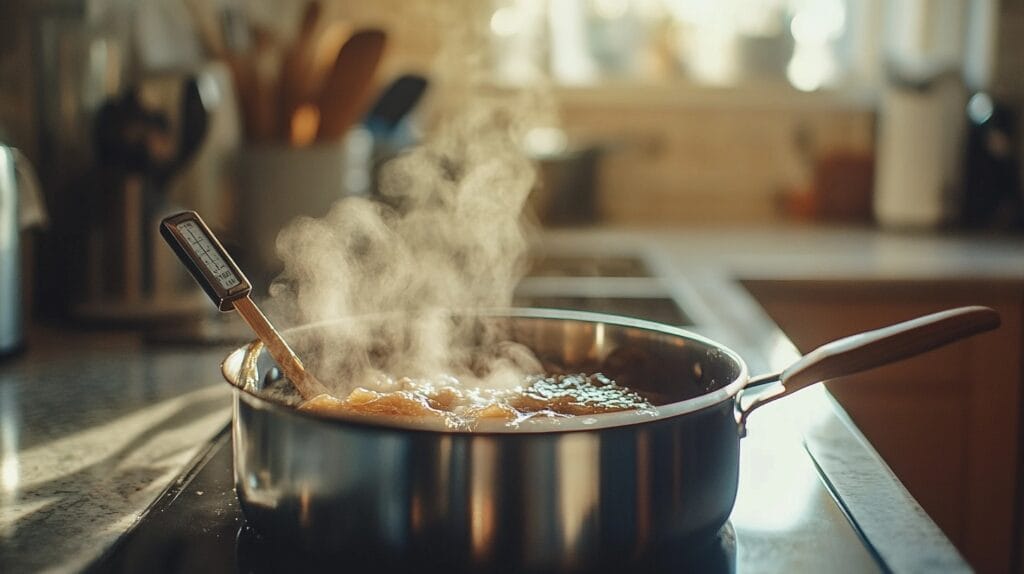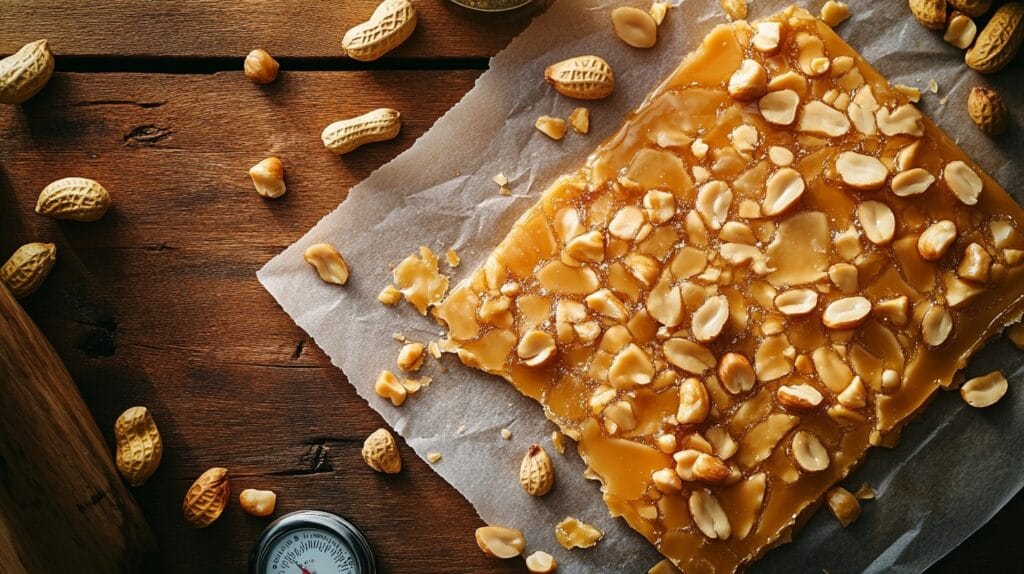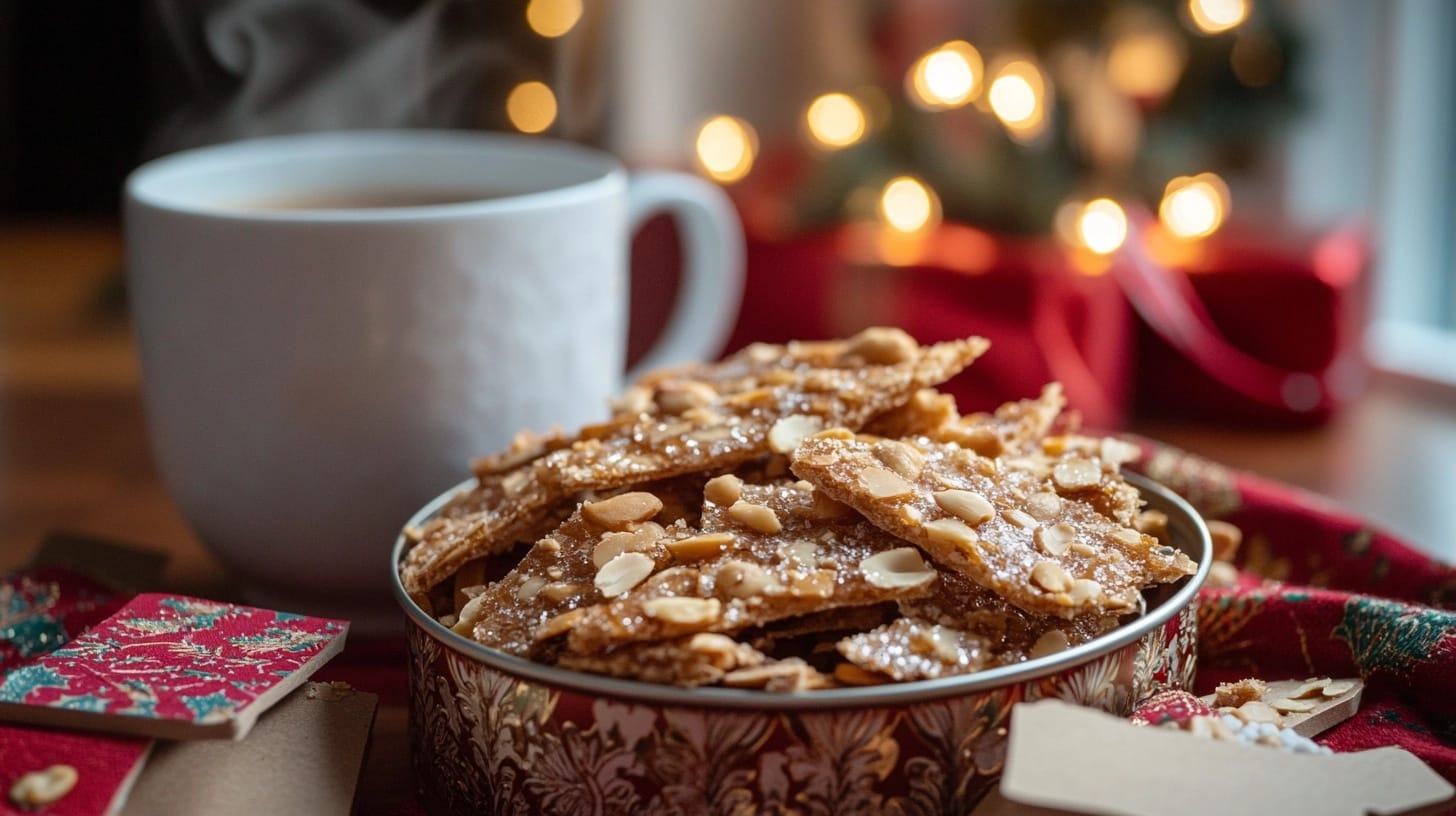Peanut brittle is a delightful, crunchy candy that has been a favorite treat for generations. Its sweet, nutty flavor and crispy texture make it an irresistible snack for any occasion. However, traditional recipes often call for corn syrup, an ingredient that not everyone has in their pantry or prefers to use. This guide is here to show you that you don’t need corn syrup to create a perfectly crunchy, delicious peanut brittle. With a few clever substitutions and simple techniques, you can whip up this classic treat right in your own kitchen.
For those who enjoy exploring baking possibilities, why not try something vibrant like lemon blueberry cupcakes? They make a fantastic complement to peanut brittle, offering a refreshing contrast with their citrusy sweetness.
Not only is this recipe beginner-friendly, but it also uses natural, accessible ingredients to achieve that classic brittle texture. Whether you’re looking to avoid processed ingredients or try something new, this recipe will fit seamlessly into your cooking repertoire. By the end of this article, you’ll be equipped with all the tips, tricks, and variations you need to make the best easy recipe for peanut brittle without corn syrup every time.
What is Peanut Brittle?
Peanut brittle is a traditional candy made by caramelizing sugar and combining it with peanuts before allowing it to cool and harden. The end result is a thin sheet of candy that’s both sweet and nutty, offering a satisfying crunch with every bite. Originating centuries ago, brittle has been a staple across various cultures, with each adding their unique twist.
In the United States, peanut brittle has become synonymous with holidays and celebrations. Its long shelf life and easy portability make it an ideal treat for gifting or sharing at gatherings. Moreover, its combination of simplicity and rich flavor ensures its place as a timeless favorite. Understanding its roots helps us appreciate this humble yet indulgent treat even more.
If you’re looking for a whimsical dessert to accompany peanut brittle, consider gender reveal cupcakes. They’re perfect for creating memorable moments at gatherings and celebrations
Why Make Peanut Brittle Without Corn Syrup?
Creating peanut brittle without corn syrup is not only possible but also offers several advantages. First, it allows you to skip processed sweeteners, opting instead for natural and widely available ingredients like granulated sugar and water. This substitution not only makes the recipe healthier but also more accessible to those who may not keep corn syrup in their kitchen.
Additionally, for individuals seeking a more natural approach to candy-making, eliminating corn syrup is a game-changer. Corn syrup is often used to prevent sugar crystallization, but with the right techniques, you can achieve the same results without it. The process may sound intimidating at first, but trust us, the satisfaction of making brittle from scratch is well worth the effort.For another culinary adventure, pair your peanut brittle with a savory dish like Traeger brisket; its rich flavors provide a delicious counterpoint to the sweetness of brittle.
Finally, making peanut brittle without corn syrup aligns with the growing trend of using natural and wholesome ingredients. This version of the recipe doesn’t compromise on taste or texture, proving that traditional methods can still produce modern results.

Ingredients for the Best Easy Recipe for Peanut Brittle Without Corn Syrup
To ensure your peanut brittle comes out perfectly every time, gathering the right ingredients is key. Each component serves a specific purpose, from flavor to texture. Below is a detailed breakdown of the ingredients you’ll need:
| Ingredient | Quantity | Purpose |
|---|---|---|
| Granulated Sugar | 2 cups | Forms the caramel base and provides sweetness. |
| Water | ½ cup | Helps dissolve the sugar evenly for smooth caramel. |
| Unsalted Butter | 2 tablespoons | Adds richness and enhances flavor. |
| Peanuts | 1½ cups | Provides the nutty crunch; raw or roasted works well. |
| Baking Soda | 1 teaspoon | Creates an airy texture by reacting with the caramel. |
| Vanilla Extract | 1 teaspoon | Adds warmth and depth to the candy’s flavor. |
Optional Add-Ins: Consider a pinch of salt for contrast or spices like cinnamon for a festive twist.
By using these simple, natural ingredients, you can create a brittle that’s both delicious and free from unnecessary additives.
Essential Tools for Making Peanut Brittle at Home
To create a flawless peanut brittle, having the right tools on hand is just as important as the ingredients. A candy thermometer is indispensable for monitoring the sugar’s temperature, ensuring you hit the hard crack stage of 300°F. A heavy-bottomed saucepan will distribute heat evenly, preventing the sugar from burning.
You’ll also need a baking sheet lined with parchment paper or a silicone mat to spread the brittle mixture. A wooden spoon or silicone spatula works best for stirring the caramel and spreading it out quickly before it hardens. Finally, measuring cups and spoons ensure you’re working with precise quantities, a crucial factor in candy-making.
Investing in these basic tools not only simplifies the process but also guarantees consistent results, allowing you to focus on mastering the technique.

Step-by-Step Instructions for Homemade Peanut Brittle
Step 1: Prepare Your Workstation
Before you begin, it’s important to have everything ready. Line a baking sheet with parchment paper or a silicone mat to prevent sticking. Measure out all your ingredients and set them within arm’s reach, as the process moves quickly once the sugar begins to cook.
Step 2: Dissolve the Sugar
In a heavy-bottomed saucepan, combine the granulated sugar and water. Stir over medium heat until the sugar dissolves completely, forming a clear solution. At this stage, avoid boiling the mixture; the goal is to achieve a smooth base.
Step 3: Caramelize the Sugar
Increase the heat to medium-high and bring the sugar mixture to a boil. Do not stir during this step, as it can cause crystallization. Instead, swirl the pan gently if needed. Use a candy thermometer to monitor the temperature closely. Once the mixture reaches 300°F (the hard crack stage), it’s time to move to the next step.
Step 4: Add Flavor and Texture
Quickly remove the pan from heat and stir in the butter, vanilla extract, and baking soda. Be cautious, as the mixture will bubble vigorously. The baking soda is crucial for creating the brittle’s airy texture, so don’t skip this step.
Fold in the peanuts, ensuring they are evenly coated with the caramel mixture. The peanuts add a savory crunch that balances the sweetness of the caramel perfectly.
Step 5: Spread and Cool
Pour the mixture onto the prepared baking sheet, using a silicone spatula or wooden spoon to spread it thinly and evenly. Work quickly, as the brittle begins to harden almost immediately. Allow the candy to cool completely before breaking it into bite-sized pieces.
Tips and Tricks for Perfect Peanut Brittle Every Time
Making peanut brittle can seem daunting, but a few tips can help you master the process with ease. Start by using fresh ingredients, especially peanuts, to ensure the best flavor and texture. When it comes to sugar, patience is key. Allow it to dissolve completely before increasing the heat, as undissolved granules can cause the caramel to crystallize.
Another essential tip is maintaining precise temperature control. A candy thermometer is invaluable for this recipe, as it ensures you hit the hard crack stage (300°F). If you don’t have one, you can test the sugar by dropping a small amount into cold water—it should form hard, brittle threads. Additionally, avoid stirring the mixture while it boils; instead, gently swirl the pan to prevent scorching.
Finally, speed is crucial during the final steps. Once the baking soda and peanuts are added, the mixture sets quickly, so be prepared to pour and spread it immediately. These tips will help you achieve consistently perfect results, leaving you with a peanut brittle that’s as delightful to make as it is to eat.

Common Mistakes to Avoid
Even seasoned cooks can encounter challenges when making peanut brittle, but knowing what to avoid can save your batch. One common mistake is overheating the sugar, which can result in a bitter, burnt flavor. Always keep a close eye on the thermometer and remove the pan from heat as soon as the mixture reaches 300°F.
Another frequent issue is skipping the use of a candy thermometer. While it’s possible to eyeball the caramel’s readiness, this often leads to undercooked or overcooked brittle. Investing in a thermometer ensures precision and eliminates guesswork.
Crystallization is another pitfall, typically caused by undissolved sugar or stirring during boiling. To prevent this, use clean utensils and avoid introducing moisture or impurities into the mixture. Lastly, don’t forget to grease your baking sheet or line it with parchment paper. Without proper preparation, the brittle may stick, making it difficult to remove cleanly.
By keeping these potential errors in mind, you can avoid setbacks and enjoy a smooth, successful candy-making experience.
Variations on the Classic Peanut Brittle Recipe
One of the joys of making peanut brittle is its versatility. While the classic recipe is a crowd pleaser, you can easily customize it to suit different tastes and occasions.
- Nut Swaps: Substitute peanuts with almonds, cashews, pecans, or even mixed nuts for a gourmet twist.
- Seed-Based Brittle: For a nut-free version, try using sunflower seeds, pumpkin seeds, or sesame seeds.
- Vegan Adaptation: Replace butter with coconut oil and ensure the sugar is plant-based to create a vegan-friendly brittle.
- Chocolate Lovers: Drizzle melted dark or milk chocolate over the cooled brittle for an indulgent treat.
- Holiday Flavors: Add spices like cinnamon, nutmeg, or cloves, or sprinkle crushed peppermint candy on top for a festive touch.
- Savory-Sweet Fusion: Incorporate a pinch of cayenne pepper or smoked paprika to create a unique flavor profile.
Experimenting with these variations allows you to tailor the recipe to different dietary needs and preferences, ensuring there’s a version of peanut brittle for everyone.
How to Store Peanut Brittle for Maximum Freshness
Proper storage is key to maintaining the crisp texture and rich flavor of your homemade peanut brittle. Once the brittle has cooled and been broken into pieces, transfer it to an airtight container. This helps prevent moisture from softening the candy.
For long-term storage, consider these options:
- Room Temperature: Store in an airtight container for up to two weeks. Keep the container in a cool, dry place, away from direct sunlight.
- Freezer Storage: Place the brittle in a resealable plastic bag and freeze for up to three months. When ready to enjoy, thaw it at room temperature before serving.
- Layer Protection: If you’re stacking pieces in a container, separate layers with parchment paper to prevent sticking.
Following these storage tips will ensure your peanut brittle remains fresh and crunchy, ready to be enjoyed whenever the craving strikes.
Pairing Ideas for Peanut Brittle
Peanut brittle is a versatile treat that pairs beautifully with other desserts and beverages. For a delightful dessert spread, consider these pairing options:
- Cookies: “Discover the secrets to perfect vanilla wafer cookies for your dessert table.”
- Ice Cream: Combine peanut brittle with a scoop of ice cream for a sweet and crunchy topping. “Pair your peanut brittle with these indulgent brownie ice cream recipes.”
- Coffee or Tea: The brittle’s sweetness complements the bitterness of coffee or the subtle flavors of herbal teas.
- Candy Bars: Incorporate pieces of brittle into homemade candy bars for added crunch. “Explore creative variations of rocky road bars for more candy-making inspiration.”
These pairings elevate peanut brittle from a simple snack to a show-stopping component of your dessert repertoire.
When to Serve Peanut Brittle
Peanut brittle is perfect for countless occasions, making it a versatile addition to your culinary arsenal. During the holidays, it shines as a homemade gift or a sweet addition to dessert tables. Packaged in decorative tins or jars, it becomes a thoughtful present for friends and family.
It’s also ideal for casual gatherings, offering a sweet and crunchy treat that pairs well with coffee or cocktails. For those quiet moments at home, a piece of peanut brittle makes for a delightful snack, satisfying your sweet tooth without much effort.
Whether it’s a special event, a holiday celebration, or a simple snack, peanut brittle fits seamlessly into any occasion, ensuring it remains a favorite for years to come.
Nutritional Information and Health Considerations
While peanut brittle is undeniably a treat, it’s helpful to know what you’re indulging in. On average, a 1-ounce piece contains about 120-150 calories, depending on the ingredients and portion size. The primary contributors are sugar and peanuts, which also provide some protein and healthy fats.
For a lighter version, you can reduce the sugar slightly or substitute half the butter with a healthier fat like coconut oil. Additionally, using unsalted peanuts or seeds helps control sodium levels.
Remember, moderation is key when enjoying this sweet snack. Although it’s tempting to indulge, pairing it with other nutritious foods can help maintain a balanced diet. By doing so, you can enjoy this treat guilt-free while keeping your overall health in check.
FAQs About Peanut Brittle Without Corn Syrup
Why add baking soda to peanut brittle?
Baking soda is a crucial ingredient in peanut brittle because it creates the candy’s signature light and airy texture. When baking soda is added to the hot caramel mixture, it reacts with the acids in the sugar and butter, releasing carbon dioxide bubbles. These bubbles expand within the mixture, giving the brittle its porous and crunchy structure. Without baking soda, the brittle would be dense and harder to bite into, lacking the delightful crispness we associate with this candy.
Why didn’t my homemade peanut brittle get hard?
If your peanut brittle didn’t harden, it’s likely because the sugar mixture didn’t reach the correct temperature during cooking. The hard crack stage, which occurs at 300°F, is necessary to ensure the brittle sets properly. If the sugar doesn’t reach this temperature, the candy may remain soft or sticky instead of becoming crisp. Always use a reliable candy thermometer to monitor the sugar’s temperature closely, and avoid removing it from the heat too early.
How do you keep peanut brittle crispy?
To keep peanut brittle crispy, store it in an airtight container at room temperature. Moisture is the enemy of brittle, as it can soften the candy and ruin its texture. If you live in a humid climate, consider adding a silica gel packet or a small bowl of dry rice to the storage container to absorb excess moisture. Avoid refrigeration, as the temperature fluctuations can cause condensation, leading to a soggy brittle.
Conclusion
Making the best easy recipe for peanut brittle without corn syrup is an enjoyable and rewarding process. With just a handful of ingredients and a bit of patience, you can create a crunchy, flavorful treat that rivals any store-bought version. Whether you’re serving it at a holiday gathering, gifting it to loved ones, or indulging in it yourself, this recipe is sure to impress. Pair it with unique recipes like gender reveal cupcakes or a hearty Traeger brisket for a complete culinary experience.
For more sweet inspiration, you can “Pair your peanut brittle with these indulgent brownie ice cream recipes” or “Explore creative variations of rocky road bars for more candy-making inspiration.” Therefore, don’t hesitate to try these combinations to elevate your dessert game. So, what are you waiting for? Get cooking today and enjoy the delicious results!

